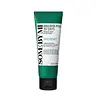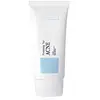What's inside
What's inside
 Key Ingredients
Key Ingredients

 Benefits
Benefits

 Concerns
Concerns

No concerns
 Ingredients Side-by-side
Ingredients Side-by-side

Water
Skin ConditioningGlycerin
HumectantCentella Asiatica Extract
CleansingPalmitic Acid
EmollientStearic Acid
CleansingLauric Acid
CleansingMyristic Acid
CleansingPotassium Hydroxide
BufferingLauryl Betaine
CleansingButylene Glycol
HumectantPEG-100 Stearate
Glyceryl Stearate
EmollientBeeswax
Emulsion StabilisingMelaleuca Alternifolia Leaf Water
AntimicrobialSodium Methyl Cocoyl Taurate
CleansingPotassium Cocoyl Glycinate
Salicylic Acid
MaskingDipropylene Glycol
HumectantSodium Chloride
MaskingHydroxyacetophenone
AntioxidantMentha Piperita Oil
MaskingCaprylyl Glycol
Emollient1,2-Hexanediol
Skin ConditioningDisodium EDTA
Hydroxyethylcellulose
Emulsion StabilisingCalamine
AbsorbentGluconolactone
Skin ConditioningCitric Acid
BufferingPotassium Glycyrrhizinate
Skin ConditioningArtemisia Vulgaris Extract
Skin ConditioningMadecassoside
AntioxidantAsiaticoside
AntioxidantAsiatic Acid
Skin ConditioningMadecassic Acid
Skin ConditioningWater, Glycerin, Centella Asiatica Extract, Palmitic Acid, Stearic Acid, Lauric Acid, Myristic Acid, Potassium Hydroxide, Lauryl Betaine, Butylene Glycol, PEG-100 Stearate, Glyceryl Stearate, Beeswax, Melaleuca Alternifolia Leaf Water, Sodium Methyl Cocoyl Taurate, Potassium Cocoyl Glycinate, Salicylic Acid, Dipropylene Glycol, Sodium Chloride, Hydroxyacetophenone, Mentha Piperita Oil, Caprylyl Glycol, 1,2-Hexanediol, Disodium EDTA, Hydroxyethylcellulose, Calamine, Gluconolactone, Citric Acid, Potassium Glycyrrhizinate, Artemisia Vulgaris Extract, Madecassoside, Asiaticoside, Asiatic Acid, Madecassic Acid
Water
Skin ConditioningGlycerin
HumectantDipropylene Glycol
HumectantMethylpropanediol
SolventGlyceryl Acrylate/Acrylic Acid Copolymer
HumectantPvm/Ma Copolymer
Emulsion StabilisingNiacinamide
SmoothingCetearyl Olivate
Sorbitan Olivate
EmulsifyingSalix Alba Bark Extract
AstringentDimethyl Sulfone
SolventPyridoxine Hcl
Skin ConditioningForsythia Suspensa Fruit Extract
AntioxidantButylene Glycol
HumectantCentella Asiatica Extract
CleansingPolygonum Cuspidatum Root Extract
AntioxidantScutellaria Baicalensis Root Extract
AstringentCamellia Sinensis Leaf Extract
AntimicrobialGlycyrrhiza Uralensis Root Extract
Skin ConditioningChamomilla Recutita Flower Extract
MaskingRosmarinus Officinalis Leaf Extract
AntimicrobialCarbomer
Emulsion StabilisingHydroxyethyl Acrylate/Sodium Acryloyldimethyl Taurate Copolymer
Emulsion StabilisingTromethamine
BufferingCopper Tripeptide-1
Skin ConditioningHydroxyacetophenone
AntioxidantMyrtus Communis Extract
AstringentTropaeolum Majus Extract
AntimicrobialEthylhexylglycerin
Skin ConditioningDisodium EDTA
Water, Glycerin, Dipropylene Glycol, Methylpropanediol, Glyceryl Acrylate/Acrylic Acid Copolymer, Pvm/Ma Copolymer, Niacinamide, Cetearyl Olivate, Sorbitan Olivate, Salix Alba Bark Extract, Dimethyl Sulfone, Pyridoxine Hcl, Forsythia Suspensa Fruit Extract, Butylene Glycol, Centella Asiatica Extract, Polygonum Cuspidatum Root Extract, Scutellaria Baicalensis Root Extract, Camellia Sinensis Leaf Extract, Glycyrrhiza Uralensis Root Extract, Chamomilla Recutita Flower Extract, Rosmarinus Officinalis Leaf Extract, Carbomer, Hydroxyethyl Acrylate/Sodium Acryloyldimethyl Taurate Copolymer, Tromethamine, Copper Tripeptide-1, Hydroxyacetophenone, Myrtus Communis Extract, Tropaeolum Majus Extract, Ethylhexylglycerin, Disodium EDTA
 Reviews
Reviews

Ingredients Explained
These ingredients are found in both products.
Ingredients higher up in an ingredient list are typically present in a larger amount.
Butylene Glycol (or BG) is used within cosmetic products for a few different reasons:
Overall, Butylene Glycol is a safe and well-rounded ingredient that works well with other ingredients.
Though this ingredient works well with most skin types, some people with sensitive skin may experience a reaction such as allergic rashes, closed comedones, or itchiness.
Learn more about Butylene GlycolCentella Asiatica Extract (Centella) is derived from an herb native to Southeast Asia. It is famous for its anti-inflammatory and soothing properties.
Centella is rich in antioxidants and amino acids, such as Madecassic Acid and Asiaticoside.
Studies show the compounds in centella help with:
The combination of all these properties makes centella effective at soothing, hydrating, and protecting the skin.
Other great components of centella include Vitamin A, vitamin C, several B vitamins, and Asiatic Acid.
Fun fact: Centella has been used as a medicine and in food for many centuries. As a medicine, it is used to treat burns, scratches, and wounds.
Learn more about Centella Asiatica ExtractDipropylene Glycol is a synthetically created humectant, stabilizer, and solvent.
This ingredient helps:
Dipropylene glycol is technically an alcohol, but it belongs to the glycol family (often considered part of the ‘good’ alcohols). This means it is hydrating and gentle on skin unlike drying solvent alcohols like denatured alcohol.
As a masking agent, Dipropylene Glycol can be used to cover the smell of other ingredients. However, it does not have a scent.
Studies show Dipropylene Glycol is considered safe to use in skincare.
Learn more about Dipropylene GlycolDisodium EDTA plays a role in making products more stable by aiding other preservatives.
It is a chelating agent, meaning it neutralizes metal ions that may be found in a product.
Disodium EDTA is a salt of edetic acid and is found to be safe in cosmetic ingredients.
Learn more about Disodium EDTAGlycerin is already naturally found in your skin. It helps moisturize and protect your skin.
A study from 2016 found glycerin to be more effective as a humectant than AHAs and hyaluronic acid.
As a humectant, it helps the skin stay hydrated by pulling moisture to your skin. The low molecular weight of glycerin allows it to pull moisture into the deeper layers of your skin.
Hydrated skin improves your skin barrier; Your skin barrier helps protect against irritants and bacteria.
Glycerin has also been found to have antimicrobial and antiviral properties. Due to these properties, glycerin is often used in wound and burn treatments.
In cosmetics, glycerin is usually derived from plants such as soybean or palm. However, it can also be sourced from animals, such as tallow or animal fat.
This ingredient is organic, colorless, odorless, and non-toxic.
Glycerin is the name for this ingredient in American English. British English uses Glycerol/Glycerine.
Learn more about GlycerinHydroxyacetophenone is antioxidant with skin conditioning and soothing properties. It also boosts the efficiency of preservatives.
This ingredient is not irritating or sensitizing.
Water. It's the most common cosmetic ingredient of all. You'll usually see it at the top of ingredient lists, meaning that it makes up the largest part of the product.
So why is it so popular? Water most often acts as a solvent - this means that it helps dissolve other ingredients into the formulation.
You'll also recognize water as that liquid we all need to stay alive. If you see this, drink a glass of water. Stay hydrated!
Learn more about Water